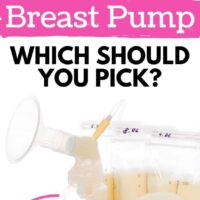This post may contain affiliate links, meaning I may earn a commission for recommending products. Read my disclosure policy for more info.
Do you plan on giving your baby breast milk? Great choice!
As you’ve probably heard, breast milk has a great deal of benefits for both mom and baby.
If you also plan to incorporate pumping, the next logical step is to choose a breast pump.
Now, that’s not always the easiest task, especially when you’re a first-time mom or you’ve never traveled down that path before (maybe you formula fed previously).
If your last search for the perfect breast pump left you feeling confused and overwhelmed, no worries!
In this comparison, we’re going to explain the difference between a manual vs. electric breast pump and try our best to help you make an informed decision.
Electric vs Manual Breast Pump: Considerations to help you choose
Each type of breast pump has its own advantages and disadvantages. Knowing what factors are important to you ahead of time will help you decide on which product will work best for your situation.
Here are a few considerations to think about.
Will you be exclusively pumping?
Will you be pumping exclusively or almost exclusively? Or do you plan to breastfeed as much as you can, with some occasional pumping thrown into the mix?
Are you concerned about the volume of milk you collect at all?
Many moms find that for large volume pumping, a double electric product is best. This version will maximize the amount of milk you can extract in less time.
Will you be returning to work soon?
A manual breast pump can be a good option for working moms. But if you are concerned about the amount of milk you will be extracting during your pumping sessions, an electric breast pump with a rechargeable battery may suit you best.
Keep in mind, although these rechargeable breast pumps are portable, they are bigger and will take up more space in your bag. You’ll also have to double-check to make sure your pump is charged and ready for the next day.
It could be beneficial to have a manual as a backup!
Will cost be a factor?
Are you concerned about your budget? Do you have any wiggle room to splurge on a higher-end electric model? The overall cost may help steer you in the direction of one type or another– Especially if you are on the fence.
Manual versions will be better suited for those who wish to stay within a lower budget.
Single or double pumping
If you only plan to pump occasionally, this feature may not matter much to you.
However, having the option to pump on both sides is a game-changer for moms who are pumping heavily.
If you want to maximize the time you spend pumping, a double model could mean all the difference.
If you wish to try double pumping with a manual pump, consider a pump that utilizes natural suction instead of a hand pump. Keep in mind, you will need to purchase two of them!
Ease of use
One other important factor to consider is how easy do you want this to be? Are you in the mood for a learning curve or do you just want to be as simple as possible?
Manual pumps are easy to control the amount of suction used, while electric pumps will only have predetermined settings.
Also, for some women, the ability to control the suction with a manual pump is more comfortable than its counterpart.
Will noise be a concern?
Although many of the newer electric pumps are designed to run quietly (such as the Spectra electric breast pumps), an electric pump will always be a little noisier than a manual pump.
Will this be an issue for you? Or do you prefer to pump more discreetly?
Manual vs electric breast pump
Manual breast pumps
Manual breast pumps do not require any electricity or batteries. Instead, they are powered entirely from the use of your hand (or sometimes with natural suction like with the Haakaa manual breast pumps).
A manual pump is a great option for moms who need to pump quietly or travel without having to worry about charging batteries or being near a power source.
These pumps also tend to be much less expensive than electric pumps. This is something to definitely think about.
Pros:
Cons:
If you plan to pump occasionally alongside breastfeeding, are on a tight budget, or prefer to not have to deal with the hassle of plugging in your pump, a manual pump could very well be everything you need.
Related: Haakaa Manual Breast Pump Review
Electric breast pumps
As the name implies, electric breast pumps have to be plugged into a power source or charged if the model comes with a rechargeable battery.
If you really want to go with an electric breast pump, but you know you’ll be on the go, an electric pump with a rechargeable battery (such as the Spectra S1) may be the perfect one for you.
Another positive about electric pumps in general– Several brands on the market have both single and double styles available. This feature helps to maximize the time you spend pumping and it keeps your milk supply strong as double pumping leads to well-drained breasts which signal your body to keep producing more milk!
An electric breast pump is a must-have if you know you will be pumping often. Your hands will thank you!
Pros:
Cons:
If you are in a time crunch, like many moms out there, you will want to make use of every minute you have. Pumping with an electric pump is easier and faster overall.
If you can afford the extra cost, it could be worth your while to opt for this version, especially if you plan to put your pump to good use.
Related: Spectra S1 vs S2 Electric Breast Pump Review and Comparison
A few common questions
When should I purchase a breast pump?
Speaking from personal experience– It’s always a good idea to go ahead and purchase your breast pump before your baby arrives.
That way, you can go ahead and read over the manual and get it sanitized and ready to go. It’s nice to not have to stress about these things while you’re adjusting to life with a newborn.
2. Are breast pumps covered under health insurance?
Some health insurance companies will cover the cost of a basic model, and some will offer upgrades. Check with your insurance provider to see what is covered.
3. Do I need to pack a pump in my hospital bag?
No, you do not have to pack it in your hospital bag. Many hospitals will have sterilized ones in the maternity ward to use if you need one while you are there.
Unless you are planning to pump exclusively, you shouldn’t need a breast pump during those first few days.
Choosing a manual breast pump vs electric is a personal choice that no one can make for you.
Some women prefer manual pumps, while others will prefer electric. Some may even own both.
As confusing as that may sound when you’re still trying to decide, try your best to hone in on what your needs will be, along with other factors, including cost and portability.
Talking to other moms can also help point you in the right direction!

